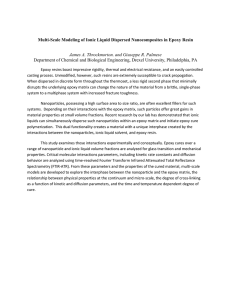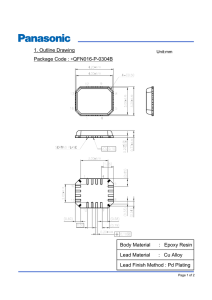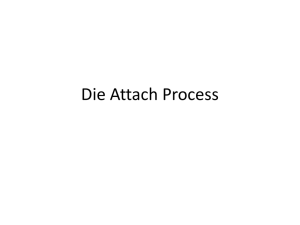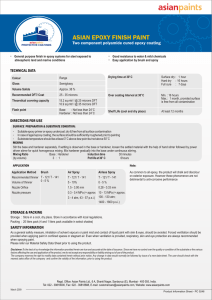EPOXY RESINS IN AUTOMOTIVE - epoxy
advertisement
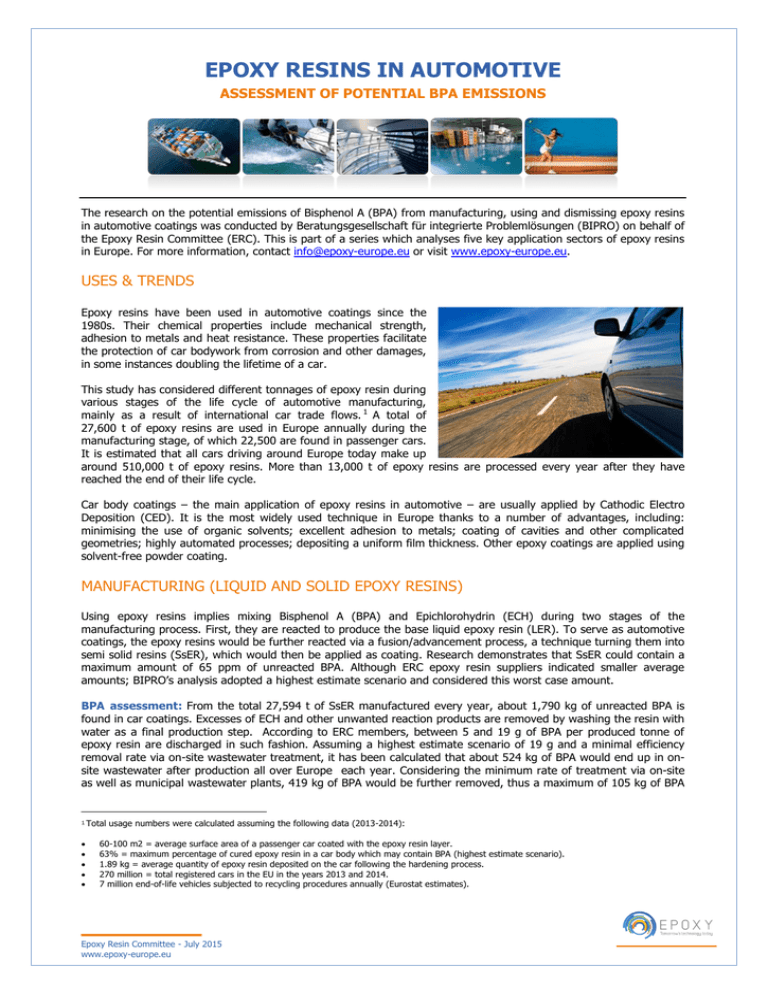
EPOXY RESINS IN AUTOMOTIVE ASSESSMENT OF POTENTIAL BPA EMISSIONS The research on the potential emissions of Bisphenol A (BPA) from manufacturing, using and dismissing epoxy resins in automotive coatings was conducted by Beratungsgesellschaft für integrierte Problemlösungen (BIPRO) on behalf of the Epoxy Resin Committee (ERC). This is part of a series which analyses five key application sectors of epoxy resins in Europe. For more information, contact info@epoxy-europe.eu or visit www.epoxy-europe.eu. USES & TRENDS Epoxy resins have been used in automotive coatings since the 1980s. Their chemical properties include mechanical strength, adhesion to metals and heat resistance. These properties facilitate the protection of car bodywork from corrosion and other damages, in some instances doubling the lifetime of a car. This study has considered different tonnages of epoxy resin during various stages of the life cycle of automotive manufacturing, mainly as a result of international car trade flows. 1 A total of 27,600 t of epoxy resins are used in Europe annually during the manufacturing stage, of which 22,500 are found in passenger cars. It is estimated that all cars driving around Europe today make up around 510,000 t of epoxy resins. More than 13,000 t of epoxy resins are processed every year after they have reached the end of their life cycle. Car body coatings – the main application of epoxy resins in automotive – are usually applied by Cathodic Electro Deposition (CED). It is the most widely used technique in Europe thanks to a number of advantages, including: minimising the use of organic solvents; excellent adhesion to metals; coating of cavities and other complicated geometries; highly automated processes; depositing a uniform film thickness. Other epoxy coatings are applied using solvent-free powder coating. MANUFACTURING (LIQUID AND SOLID EPOXY RESINS) Using epoxy resins implies mixing Bisphenol A (BPA) and Epichlorohydrin (ECH) during two stages of the manufacturing process. First, they are reacted to produce the base liquid epoxy resin (LER). To serve as automotive coatings, the epoxy resins would be further reacted via a fusion/advancement process, a technique turning them into semi solid resins (SsER), which would then be applied as coating. Research demonstrates that SsER could contain a maximum amount of 65 ppm of unreacted BPA. Although ERC epoxy resin suppliers indicated smaller average amounts; BIPRO’s analysis adopted a highest estimate scenario and considered this worst case amount. BPA assessment: From the total 27,594 t of SsER manufactured every year, about 1,790 kg of unreacted BPA is found in car coatings. Excesses of ECH and other unwanted reaction products are removed by washing the resin with water as a final production step. According to ERC members, between 5 and 19 g of BPA per produced tonne of epoxy resin are discharged in such fashion. Assuming a highest estimate scenario of 19 g and a minimal efficiency removal rate via on-site wastewater treatment, it has been calculated that about 524 kg of BPA would end up in onsite wastewater after production all over Europe each year. Considering the minimum rate of treatment via on-site as well as municipal wastewater plants, 419 kg of BPA would be further removed, thus a maximum of 105 kg of BPA 1 Total usage numbers were calculated assuming the following data (2013-2014): 60-100 m2 = average surface area of a passenger car coated with the epoxy resin layer. 63% = maximum percentage of cured epoxy resin in a car body which may contain BPA (highest estimate scenario). 1.89 kg = average quantity of epoxy resin deposited on the car following the hardening process. 270 million = total registered cars in the EU in the years 2013 and 2014. 7 million end-of-life vehicles subjected to recycling procedures annually (Eurostat estimates). Epoxy Resin Committee - July 2015 www.epoxy-europe.eu may finally enter water bodies. Biotic and abiotic degradation will likely further reduce this amount, although no reliable estimates are possible in this case. APPLICATION STAGE (COATING) During the CED process, the epoxy resin layer is the first of five organic layers coating the metallic bodywork of a car. Usually approximately 20μ m thick, it has been estimated 2 to 8 kg of epoxy are needed per car to act as primer for further layers to be placed on top of the epoxy coating. The process involves immersing the car body for ± 4 minutes in an electrodeposition bath. An electrical charge applied on the car body deposits the positively charged epoxy resin to create a new layer. The bath consists of an epoxy-amine adduct and a blocked isocyanate to crosslink the adduct. The amine adduct is prepared by paint manufacturers and delivered in large tanks to the automotive factory. Residues may remain in the tank after the amine content is emptied in the coating tanks. During the cleaning of the latter, residues may be washed away and disposed of via wastewater but cannot be quantified. Curing of the epoxy layer is conducted after rinsing and drying operations which are carried out after the car body leaves the tank. Sources of epoxy losses during coating can include: Cleaning the electrodeposition tank (primer residues may accumulate as sludge in washing water). Replacing the filters of the ultrafiltration clog; the residues of which can result in solid waste. Collecting water resulting from bath overflow. Coating defects on the car, revealed only after drying. BPA assessment: Calculating the BPA losses which occur during coating requires acknowledging a number of uncertainties. Cleaning CED tanks generates between 60 g and 120 g of sludge per produced car, of which about 4050% consists of epoxy-amine adduct with unreacted BPA. Assuming a highest estimate scenario, 54 g of epoxy resins may be found in the resulting sludge. Considering the number of cars manufactured in Europe each year, the resulting 788 t of sludge could include up to 51 kg of residual BPA. The latter may be treated through incineration or other disposal methods. Coating filters are disposed of every 10 cars according to a car manufacturer contacted for this analysis. This would result in 1.46 million filters being discarded. However, no available data could confirm average residuals in filters or their disposal methods. However, CED was designed to maximise deposition of epoxy on car bodies, thus minimal epoxy, and therefore BPA, residues can be expected from this source. No significant BPA losses are expected during drying of the coating. Temperature would rise up to 150-190° C and should any part of the coating escape - including residual BPA - it would be thermally decomposed in the abatement part of the oven. SERVICE LIFE During service life, paintwork is exposed to mechanical and chemical wear and tear. Gravel, sand and salt can cause damage, as well as insects or bird droppings and UV light. Damage could be observed as a loss of gloss, colour changes, yellowing, cracks or delamination of coating layers which may also affect the epoxy coating. This analysis assumed the average service life of a car in Germany (18 years from production), which is completely in line with the availability period of spare parts in many parts of Europe (usually 20 years from production). BPA assessment: A maximum 1% of the epoxy originally applied could be lost during service life. Assuming that each car contains an average of 1.89 kg of epoxy resin, 19 g could flake off (a total amount of 225 t annually). Adopting a highest estimate scenario, 15 kg of BPA could potentially enter the environment every year (330 kg of BPA for all cars currently registered in Europe during their whole service life). The fate of BPA released into the environment remains subject to analysis. As of today, there is no certain quantitative assessment of potential BPA release into the environment (various factors would play a role, from UV light to liquid of various composition and others). Epoxy Resin Committee - July 2015 www.epoxy-europe.eu END OF LIFE Management of end-of-life vehicles is outlined by the European Parliament and Council Directive 2000/53/EC which defines specific measures to be put in place concerning collection, storage, treatment, dismantling, re-use and recycling of end-of-life vehicles. Recycling includes dismantling the car bodywork via pressing and shredding, which may result in parts of the epoxy coating flaking off. Shredders normally dissemble cars together with household appliances, electronic equipment, etc. For this reason, the estimated amount of end-of-life vehicles processed at shredding facilities is rather broad (2785% of processed waste). Another step of the recycling process is sorting, during which various materials (e.g. plastics, glass, sand, etc.) are separated. According to recyclers, the coating of a car would end up in the shredder light fraction (SLF), which also contains plastics, glass, wood, paint, particles and textiles. BPA assessment: The majority of SLF is currently landfilled. However other options are possible and include recovery, incineration (energy recovery) and recycling. Another application - although it seems to apply only in Germany – is reusing SLF as filling in disused mines. Neither landfills nor reuse in mines entail the degradation of epoxy resin and its residual BPA. Its potential release in the environment would depend on weather conditions and state of the landfill. A reliable quantification of emissions is not possible for this stage. CONCLUSIONS Nearly 28,000 tonnes of BPA-based epoxy resins are used to coat cars manufactured in Europe every year. CED, the dominant coating technology in Europe, uses primarily semi-solid epoxy resins and produces about 1,790 kg of unreacted BPA in coatings, of which a maximum 105 kg of BPA is expected to be released in the environment. An additional 51 kg is expected to be released as sludge when washing dipping tanks during the coating manufacturing and installation. An additional 15 kg of BPA is expected to be released into the environment annually during service life. No data were available for the waste stage. Automotive coating Annual BPA releases into environment Annual epoxy usage mass (2013) Production Application Service life Waste Total 27,600 t max 105 kg max 51 kg max 15 kg not determinable > 171 kg Epoxy Resin Committee - July 2015 www.epoxy-europe.eu ANNEX: Life cycle stages and related BPA release for automotive coating Epoxy Resin Committee - July 2015 www.epoxy-europe.eu
